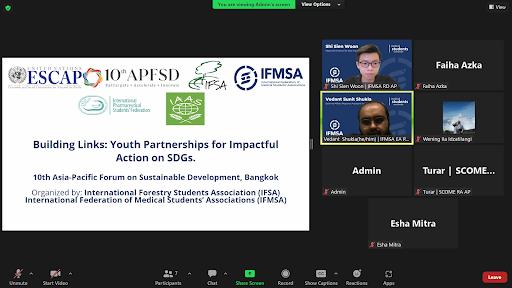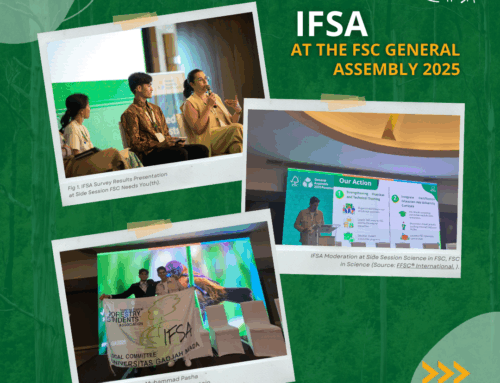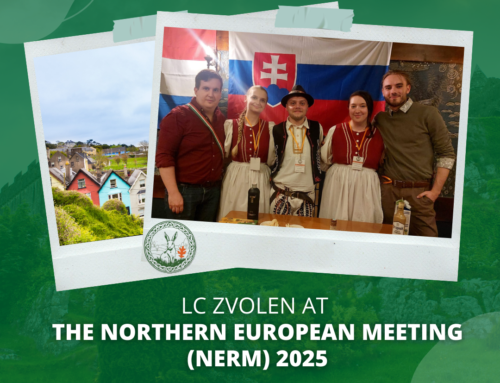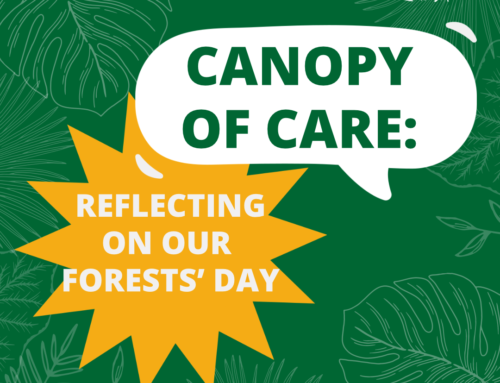Building Links: Youth Partnerships for Impactful Action on SDGs at the 10th Asia Pacific Forum on Sustainable Development
In March this year, IFSA, along with our co-organizers IFMSA (International Federation of Medical Students Association), organized a virtual side event titled “Building Links: Youth Partnerships for Impactful Action on SDGs” at the 10th Asia Pacific Forum on Sustainable Development (APFSD), bringing together a diverse panel of young experts from the APAC region and discuss our stories and pathways towards global youth partnerships. Our partner speakers from IAAS (International Association of Students in Agricultural and Related Sciences) and IPSF (International Pharmaceutical Students Federation) joined us.

IFSA’s side event at the 10th APFSD.
The presenters during the event were Esha Mitra(IFSA Head of International Processes Commission), Shi Sien Woon (IFMSA Regional Director for Asia Pacific), Yivan Zhou (IPSF Chairperson of External Relations), and Prem Prakash Budhathoki (IAAS Asia Pacific Regional External Relations Coordinator). The event highlighted the significance of developing youth collaborations to accelerate progress towards the SDGs – by discussing ways to empower youth to form meaningful alliances to make a long-term impact during the Asia-Pacific COVID-19 recovery period, bring best practices from across the region together and the pathways forward that can be suggested to policymakers, civil society, and other stakeholders. The speakers shared their journey of their youth-led organizations and their role towards implementation of SDGs, with a focus on SDGs 6,7,9,11 to enhance the knowledge and capacity of on-ground youth projects conducted by students and youth; and build networks/linkages.
The issue of climate change and the importance of resilient forests is such an important issue highlighted by Esha from IFSA. Here the role of youth as the future professional forester is not limited to learning how the forest should be managed but also involved in decision-making. It is also in line with the presentation from IFMSA that believes the global organization is a great way to exchange ideas. For example, the webinar that IFMSA has held about menstruation hygiene in areas with less water. A very informative session that also showed how youth can be the catalyst of knowledge development itself.
Prem then continued the presentation from IAAS. Prem presented IAAS as a place for youth to have a mutual understanding of global challenges with a focus on agriculture. As we know, agriculture is very important as it is related to human livelihood. Here, youth understand what is happening and the future impactor and take action. Yifan Zhou brought the last presentation from IPSF. She explained how UN Bodies and intergovernmental agencies make partnerships with youth. Empowering the youth can be through: collaboration (funding, planning, promotion, and connection), increasing visibility, and engaging youth in high-level processes such as co-research or decision-making.
International organizations are a good place for youth to have a strong background in having a mutual understanding of the global situation of their knowledge. It is also a good simulation of how to behave as a professional on an international level in their own expertise. In this level and the internet era, student organizations provide an inclusive opportunity for youth to impact their expertise by collaborating with others by bringing their ideas and authenticity. As the next level of youth partnership, an inter-student organization is a good way to elevate the youth’s engagement to reach the SDGs’ goal.
From representing each organization and what movement has been made, we see that IFSA, IFMSA, IAAS, and IPSF have been a consistent part of SDG development, providing a platform to youth in the tracking and decision-making of the international policy sector, which aligns with SDG 17 target of cultivating partnership for the goals.

Group photo at the event.
In conclusion, the event can answer how youth partnership can accelerate the achievement of the SDGs, how youth can build projects from scratch, what UN Bodies and intergovernmental agencies take to make partnerships with youth organizations, and what ways to achieve youth partnerships that are effective and sustainable. We hope this inspires and contributes to building networks and partnerships between youth.
Authors: Damya Srivastava, Wening Ila Idzatilangi



